Sustainable System: Energy Efficiency in Homes
VerifiedAdded on 2023/06/04
|11
|2172
|405
AI Summary
This paper explores energy efficiency and its utilization in NSW, New South Wales Australia in line with home and household applications. It evaluates the challenges and remedies to curb difficulties. The study also discusses the sources of energy, environmental impacts of energy and carbon dioxide emissions in Australia, and opportunities to decrease energy consumption.
Contribute Materials
Your contribution can guide someone’s learning journey. Share your
documents today.
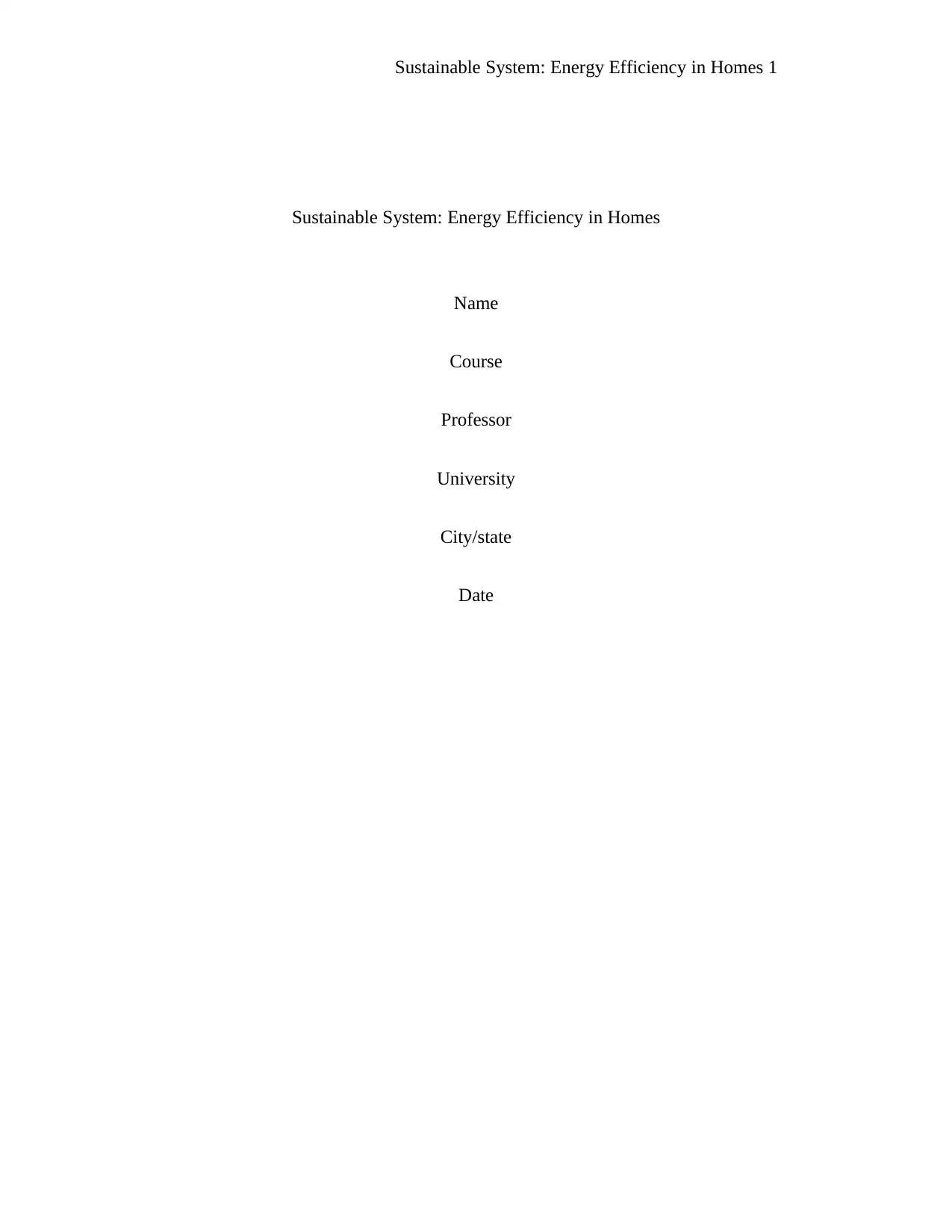
Sustainable System: Energy Efficiency in Homes 1
Sustainable System: Energy Efficiency in Homes
Name
Course
Professor
University
City/state
Date
Sustainable System: Energy Efficiency in Homes
Name
Course
Professor
University
City/state
Date
Secure Best Marks with AI Grader
Need help grading? Try our AI Grader for instant feedback on your assignments.
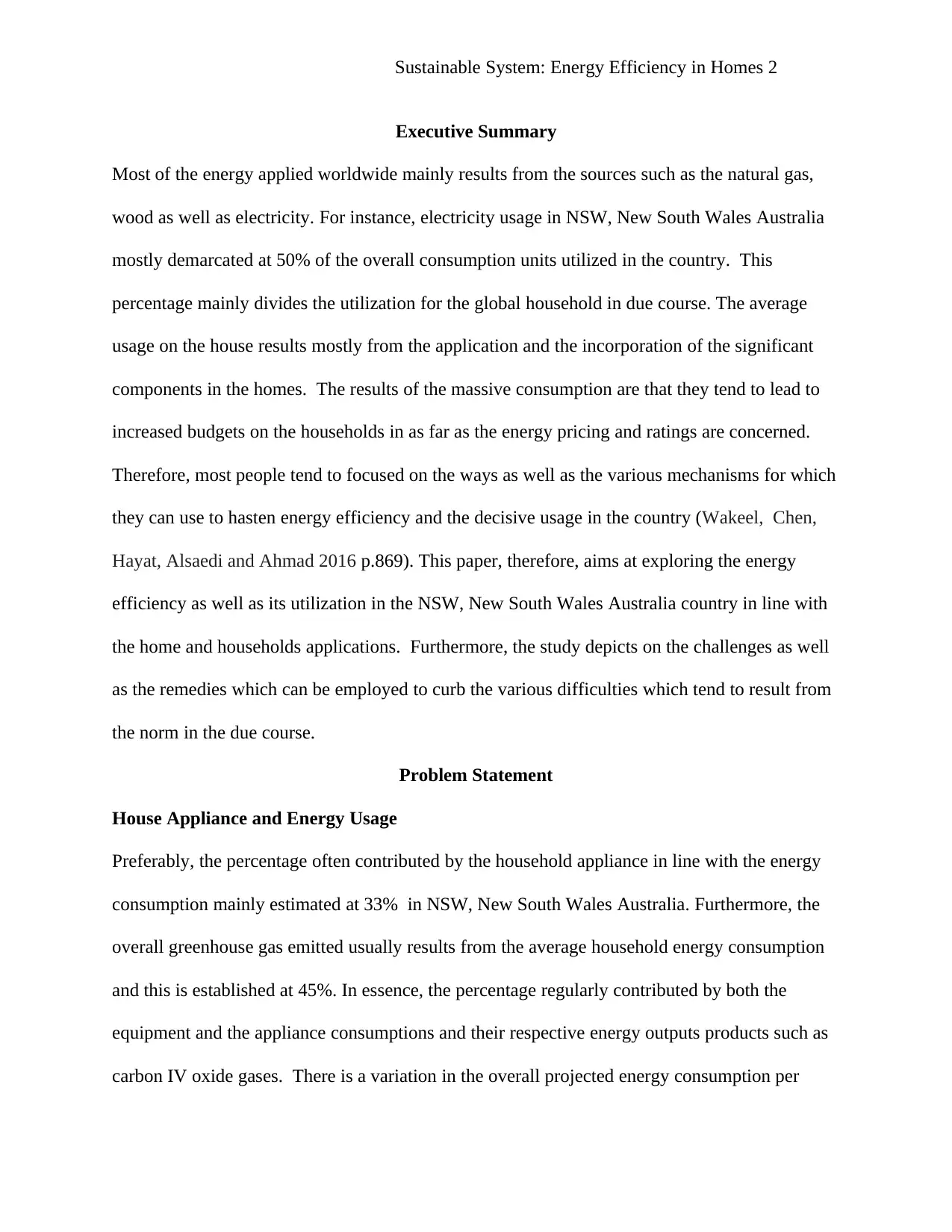
Sustainable System: Energy Efficiency in Homes 2
Executive Summary
Most of the energy applied worldwide mainly results from the sources such as the natural gas,
wood as well as electricity. For instance, electricity usage in NSW, New South Wales Australia
mostly demarcated at 50% of the overall consumption units utilized in the country. This
percentage mainly divides the utilization for the global household in due course. The average
usage on the house results mostly from the application and the incorporation of the significant
components in the homes. The results of the massive consumption are that they tend to lead to
increased budgets on the households in as far as the energy pricing and ratings are concerned.
Therefore, most people tend to focused on the ways as well as the various mechanisms for which
they can use to hasten energy efficiency and the decisive usage in the country (Wakeel, Chen,
Hayat, Alsaedi and Ahmad 2016 p.869). This paper, therefore, aims at exploring the energy
efficiency as well as its utilization in the NSW, New South Wales Australia country in line with
the home and households applications. Furthermore, the study depicts on the challenges as well
as the remedies which can be employed to curb the various difficulties which tend to result from
the norm in the due course.
Problem Statement
House Appliance and Energy Usage
Preferably, the percentage often contributed by the household appliance in line with the energy
consumption mainly estimated at 33% in NSW, New South Wales Australia. Furthermore, the
overall greenhouse gas emitted usually results from the average household energy consumption
and this is established at 45%. In essence, the percentage regularly contributed by both the
equipment and the appliance consumptions and their respective energy outputs products such as
carbon IV oxide gases. There is a variation in the overall projected energy consumption per
Executive Summary
Most of the energy applied worldwide mainly results from the sources such as the natural gas,
wood as well as electricity. For instance, electricity usage in NSW, New South Wales Australia
mostly demarcated at 50% of the overall consumption units utilized in the country. This
percentage mainly divides the utilization for the global household in due course. The average
usage on the house results mostly from the application and the incorporation of the significant
components in the homes. The results of the massive consumption are that they tend to lead to
increased budgets on the households in as far as the energy pricing and ratings are concerned.
Therefore, most people tend to focused on the ways as well as the various mechanisms for which
they can use to hasten energy efficiency and the decisive usage in the country (Wakeel, Chen,
Hayat, Alsaedi and Ahmad 2016 p.869). This paper, therefore, aims at exploring the energy
efficiency as well as its utilization in the NSW, New South Wales Australia country in line with
the home and households applications. Furthermore, the study depicts on the challenges as well
as the remedies which can be employed to curb the various difficulties which tend to result from
the norm in the due course.
Problem Statement
House Appliance and Energy Usage
Preferably, the percentage often contributed by the household appliance in line with the energy
consumption mainly estimated at 33% in NSW, New South Wales Australia. Furthermore, the
overall greenhouse gas emitted usually results from the average household energy consumption
and this is established at 45%. In essence, the percentage regularly contributed by both the
equipment and the appliance consumptions and their respective energy outputs products such as
carbon IV oxide gases. There is a variation in the overall projected energy consumption per
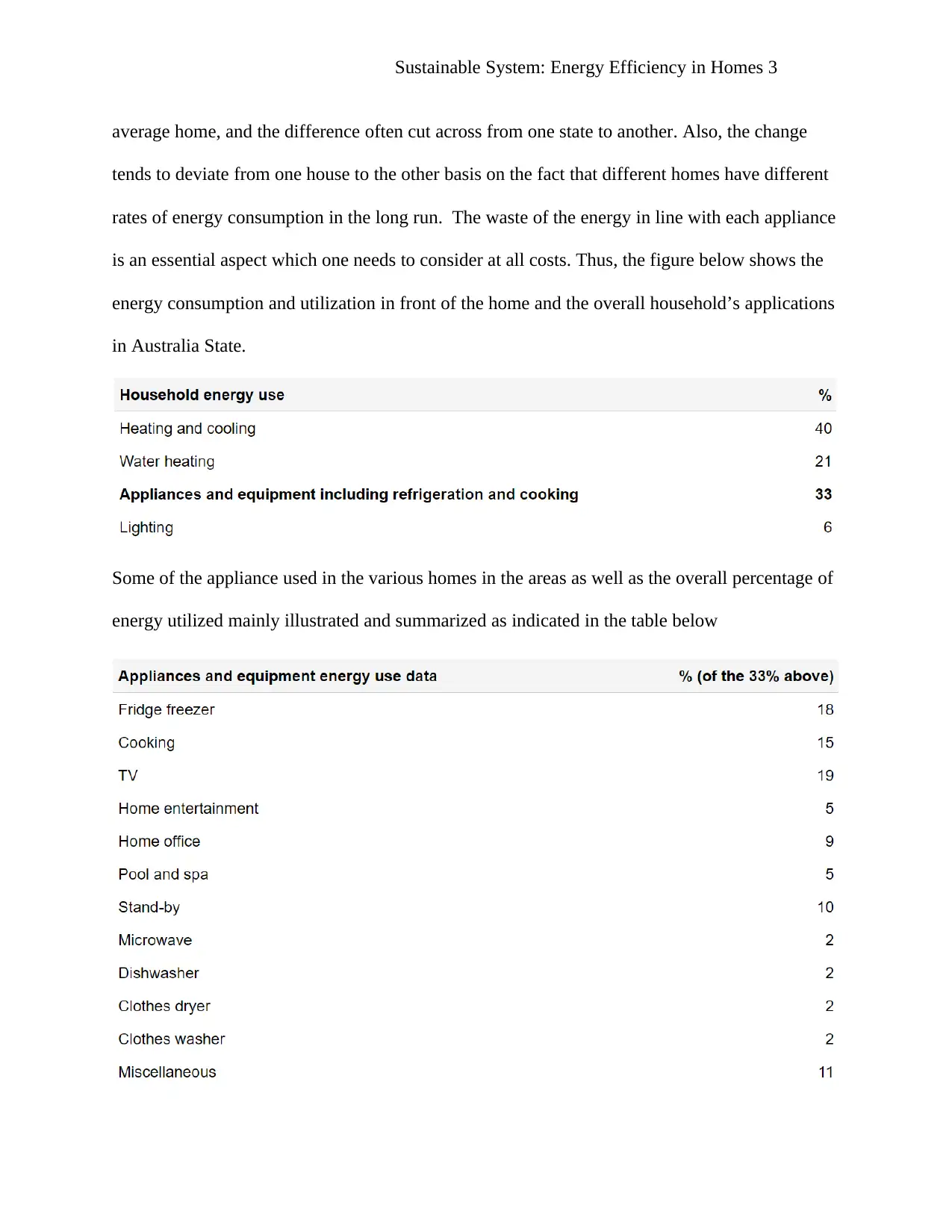
Sustainable System: Energy Efficiency in Homes 3
average home, and the difference often cut across from one state to another. Also, the change
tends to deviate from one house to the other basis on the fact that different homes have different
rates of energy consumption in the long run. The waste of the energy in line with each appliance
is an essential aspect which one needs to consider at all costs. Thus, the figure below shows the
energy consumption and utilization in front of the home and the overall household’s applications
in Australia State.
Some of the appliance used in the various homes in the areas as well as the overall percentage of
energy utilized mainly illustrated and summarized as indicated in the table below
average home, and the difference often cut across from one state to another. Also, the change
tends to deviate from one house to the other basis on the fact that different homes have different
rates of energy consumption in the long run. The waste of the energy in line with each appliance
is an essential aspect which one needs to consider at all costs. Thus, the figure below shows the
energy consumption and utilization in front of the home and the overall household’s applications
in Australia State.
Some of the appliance used in the various homes in the areas as well as the overall percentage of
energy utilized mainly illustrated and summarized as indicated in the table below
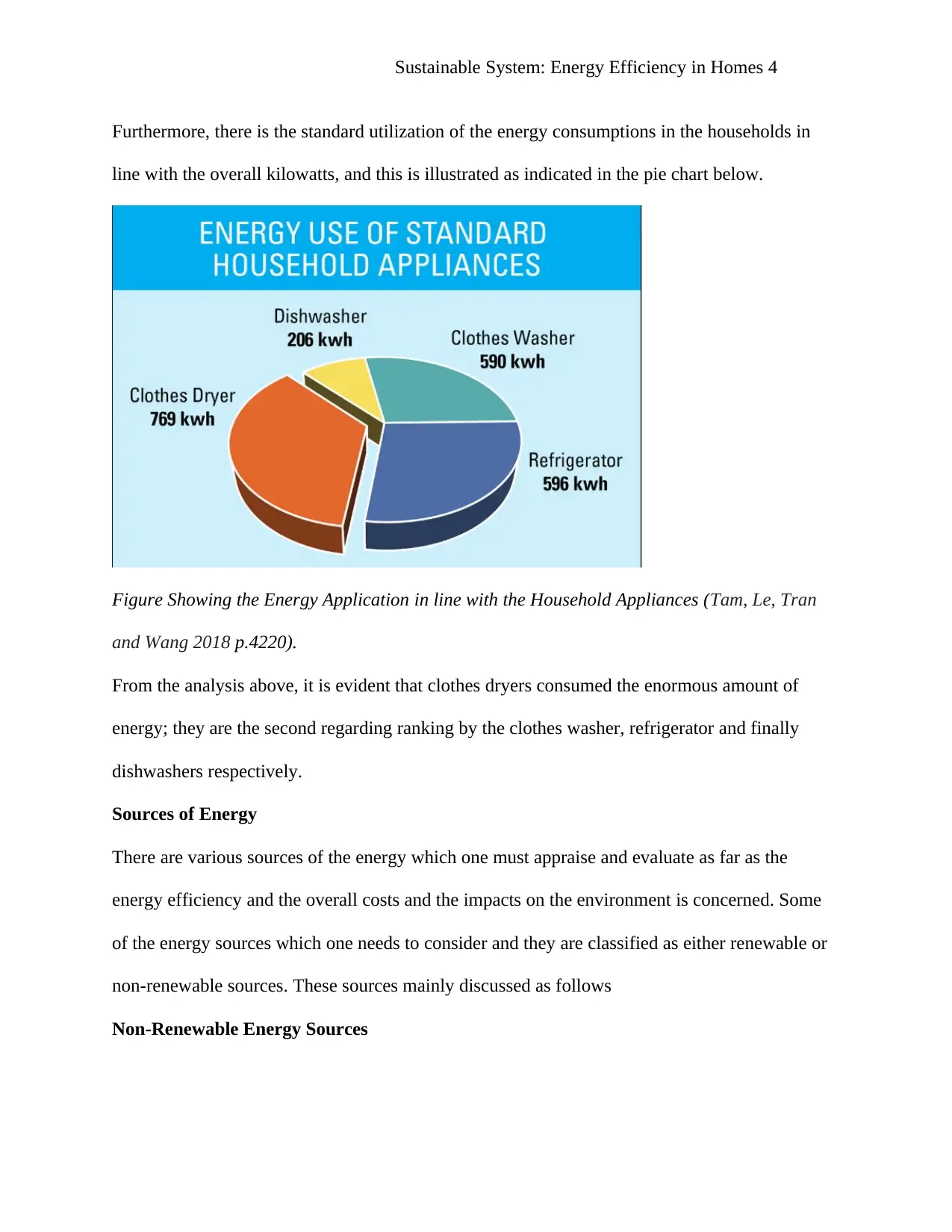
Sustainable System: Energy Efficiency in Homes 4
Furthermore, there is the standard utilization of the energy consumptions in the households in
line with the overall kilowatts, and this is illustrated as indicated in the pie chart below.
Figure Showing the Energy Application in line with the Household Appliances (Tam, Le, Tran
and Wang 2018 p.4220).
From the analysis above, it is evident that clothes dryers consumed the enormous amount of
energy; they are the second regarding ranking by the clothes washer, refrigerator and finally
dishwashers respectively.
Sources of Energy
There are various sources of the energy which one must appraise and evaluate as far as the
energy efficiency and the overall costs and the impacts on the environment is concerned. Some
of the energy sources which one needs to consider and they are classified as either renewable or
non-renewable sources. These sources mainly discussed as follows
Non-Renewable Energy Sources
Furthermore, there is the standard utilization of the energy consumptions in the households in
line with the overall kilowatts, and this is illustrated as indicated in the pie chart below.
Figure Showing the Energy Application in line with the Household Appliances (Tam, Le, Tran
and Wang 2018 p.4220).
From the analysis above, it is evident that clothes dryers consumed the enormous amount of
energy; they are the second regarding ranking by the clothes washer, refrigerator and finally
dishwashers respectively.
Sources of Energy
There are various sources of the energy which one must appraise and evaluate as far as the
energy efficiency and the overall costs and the impacts on the environment is concerned. Some
of the energy sources which one needs to consider and they are classified as either renewable or
non-renewable sources. These sources mainly discussed as follows
Non-Renewable Energy Sources
Secure Best Marks with AI Grader
Need help grading? Try our AI Grader for instant feedback on your assignments.
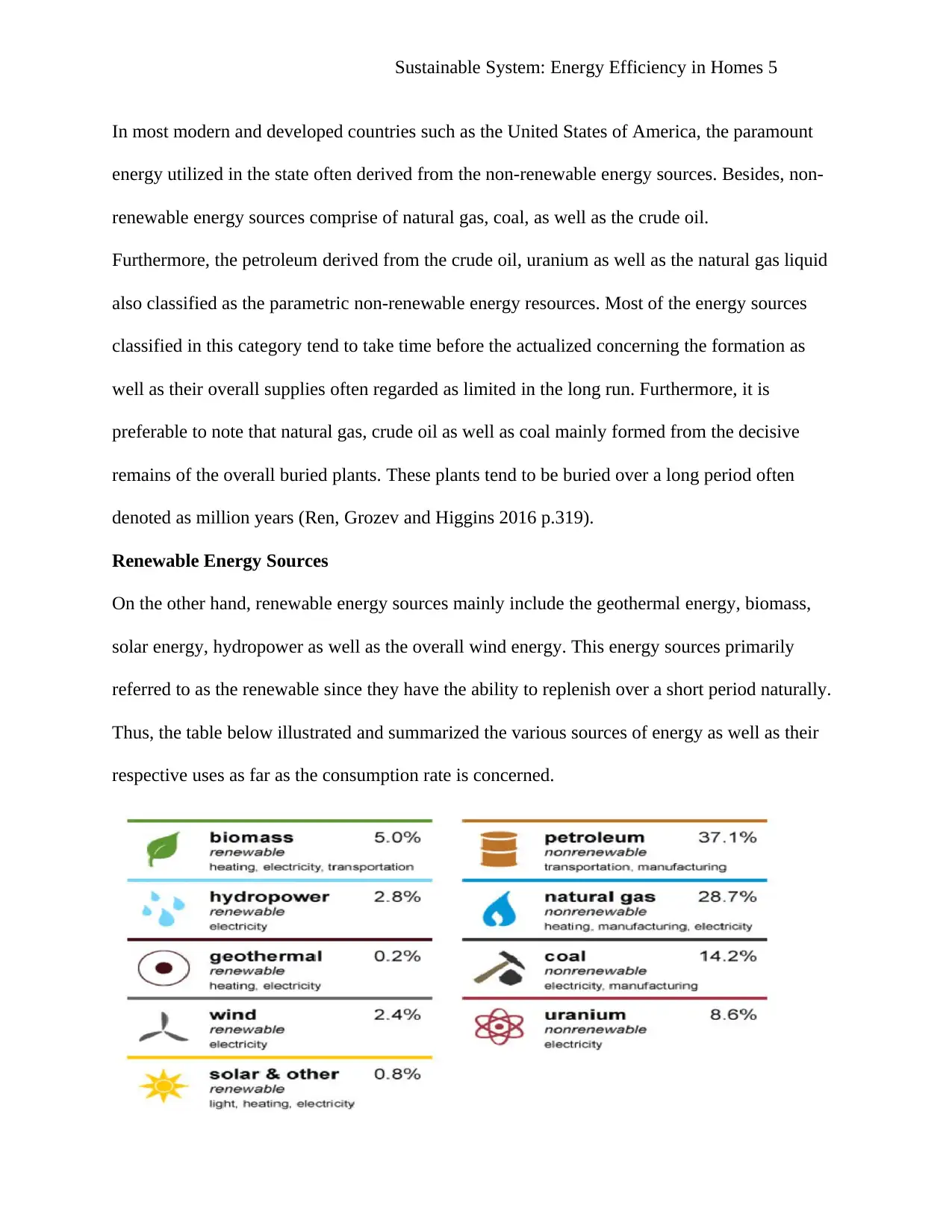
Sustainable System: Energy Efficiency in Homes 5
In most modern and developed countries such as the United States of America, the paramount
energy utilized in the state often derived from the non-renewable energy sources. Besides, non-
renewable energy sources comprise of natural gas, coal, as well as the crude oil.
Furthermore, the petroleum derived from the crude oil, uranium as well as the natural gas liquid
also classified as the parametric non-renewable energy resources. Most of the energy sources
classified in this category tend to take time before the actualized concerning the formation as
well as their overall supplies often regarded as limited in the long run. Furthermore, it is
preferable to note that natural gas, crude oil as well as coal mainly formed from the decisive
remains of the overall buried plants. These plants tend to be buried over a long period often
denoted as million years (Ren, Grozev and Higgins 2016 p.319).
Renewable Energy Sources
On the other hand, renewable energy sources mainly include the geothermal energy, biomass,
solar energy, hydropower as well as the overall wind energy. This energy sources primarily
referred to as the renewable since they have the ability to replenish over a short period naturally.
Thus, the table below illustrated and summarized the various sources of energy as well as their
respective uses as far as the consumption rate is concerned.
In most modern and developed countries such as the United States of America, the paramount
energy utilized in the state often derived from the non-renewable energy sources. Besides, non-
renewable energy sources comprise of natural gas, coal, as well as the crude oil.
Furthermore, the petroleum derived from the crude oil, uranium as well as the natural gas liquid
also classified as the parametric non-renewable energy resources. Most of the energy sources
classified in this category tend to take time before the actualized concerning the formation as
well as their overall supplies often regarded as limited in the long run. Furthermore, it is
preferable to note that natural gas, crude oil as well as coal mainly formed from the decisive
remains of the overall buried plants. These plants tend to be buried over a long period often
denoted as million years (Ren, Grozev and Higgins 2016 p.319).
Renewable Energy Sources
On the other hand, renewable energy sources mainly include the geothermal energy, biomass,
solar energy, hydropower as well as the overall wind energy. This energy sources primarily
referred to as the renewable since they have the ability to replenish over a short period naturally.
Thus, the table below illustrated and summarized the various sources of energy as well as their
respective uses as far as the consumption rate is concerned.
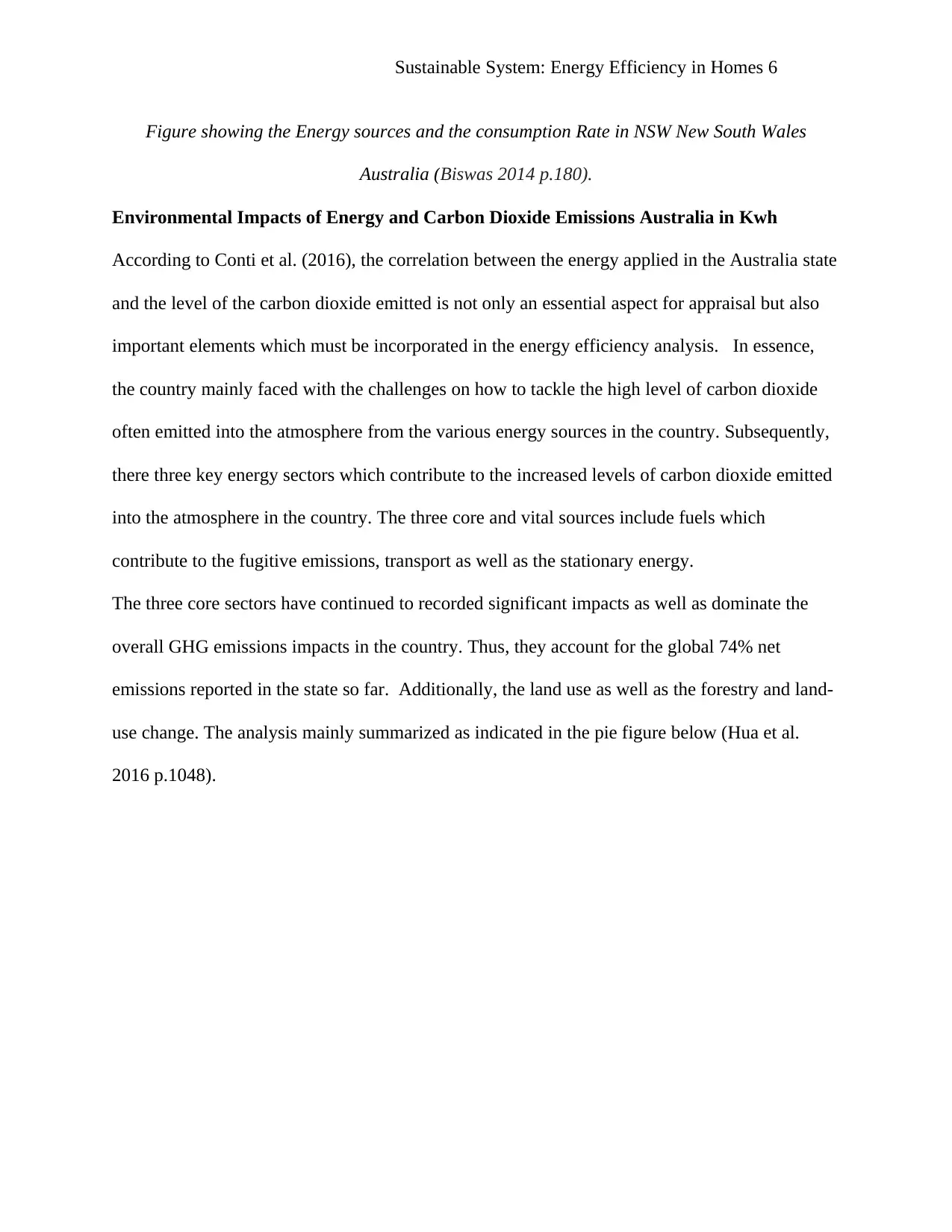
Sustainable System: Energy Efficiency in Homes 6
Figure showing the Energy sources and the consumption Rate in NSW New South Wales
Australia (Biswas 2014 p.180).
Environmental Impacts of Energy and Carbon Dioxide Emissions Australia in Kwh
According to Conti et al. (2016), the correlation between the energy applied in the Australia state
and the level of the carbon dioxide emitted is not only an essential aspect for appraisal but also
important elements which must be incorporated in the energy efficiency analysis. In essence,
the country mainly faced with the challenges on how to tackle the high level of carbon dioxide
often emitted into the atmosphere from the various energy sources in the country. Subsequently,
there three key energy sectors which contribute to the increased levels of carbon dioxide emitted
into the atmosphere in the country. The three core and vital sources include fuels which
contribute to the fugitive emissions, transport as well as the stationary energy.
The three core sectors have continued to recorded significant impacts as well as dominate the
overall GHG emissions impacts in the country. Thus, they account for the global 74% net
emissions reported in the state so far. Additionally, the land use as well as the forestry and land-
use change. The analysis mainly summarized as indicated in the pie figure below (Hua et al.
2016 p.1048).
Figure showing the Energy sources and the consumption Rate in NSW New South Wales
Australia (Biswas 2014 p.180).
Environmental Impacts of Energy and Carbon Dioxide Emissions Australia in Kwh
According to Conti et al. (2016), the correlation between the energy applied in the Australia state
and the level of the carbon dioxide emitted is not only an essential aspect for appraisal but also
important elements which must be incorporated in the energy efficiency analysis. In essence,
the country mainly faced with the challenges on how to tackle the high level of carbon dioxide
often emitted into the atmosphere from the various energy sources in the country. Subsequently,
there three key energy sectors which contribute to the increased levels of carbon dioxide emitted
into the atmosphere in the country. The three core and vital sources include fuels which
contribute to the fugitive emissions, transport as well as the stationary energy.
The three core sectors have continued to recorded significant impacts as well as dominate the
overall GHG emissions impacts in the country. Thus, they account for the global 74% net
emissions reported in the state so far. Additionally, the land use as well as the forestry and land-
use change. The analysis mainly summarized as indicated in the pie figure below (Hua et al.
2016 p.1048).

Sustainable System: Energy Efficiency in Homes 7
Figure Showing the Various Energy Sources and the Carbon Dioxide Emissions Associated in
NSW, New South Wales Australia (Alobaidi, Chebana and Meguid 2018 p.998).
From the pie chart above, it is evidential that stationary energy leads in line with the overall
carbon dioxide emitted into the atmosphere. The level mainly contributed to the increased fuel's
energy burned in the combustion process to process the fuel energy. Some of the key
contributors in this category include crude oil and coal.
Furthermore, the levels of the emissions recorded in the country as far as the analysis in line with
2009 are concerned mainly indicated as shown in the diagram below
Figure Showing the Various Energy Sources and the Carbon Dioxide Emissions Associated in
NSW, New South Wales Australia (Alobaidi, Chebana and Meguid 2018 p.998).
From the pie chart above, it is evidential that stationary energy leads in line with the overall
carbon dioxide emitted into the atmosphere. The level mainly contributed to the increased fuel's
energy burned in the combustion process to process the fuel energy. Some of the key
contributors in this category include crude oil and coal.
Furthermore, the levels of the emissions recorded in the country as far as the analysis in line with
2009 are concerned mainly indicated as shown in the diagram below
Paraphrase This Document
Need a fresh take? Get an instant paraphrase of this document with our AI Paraphraser
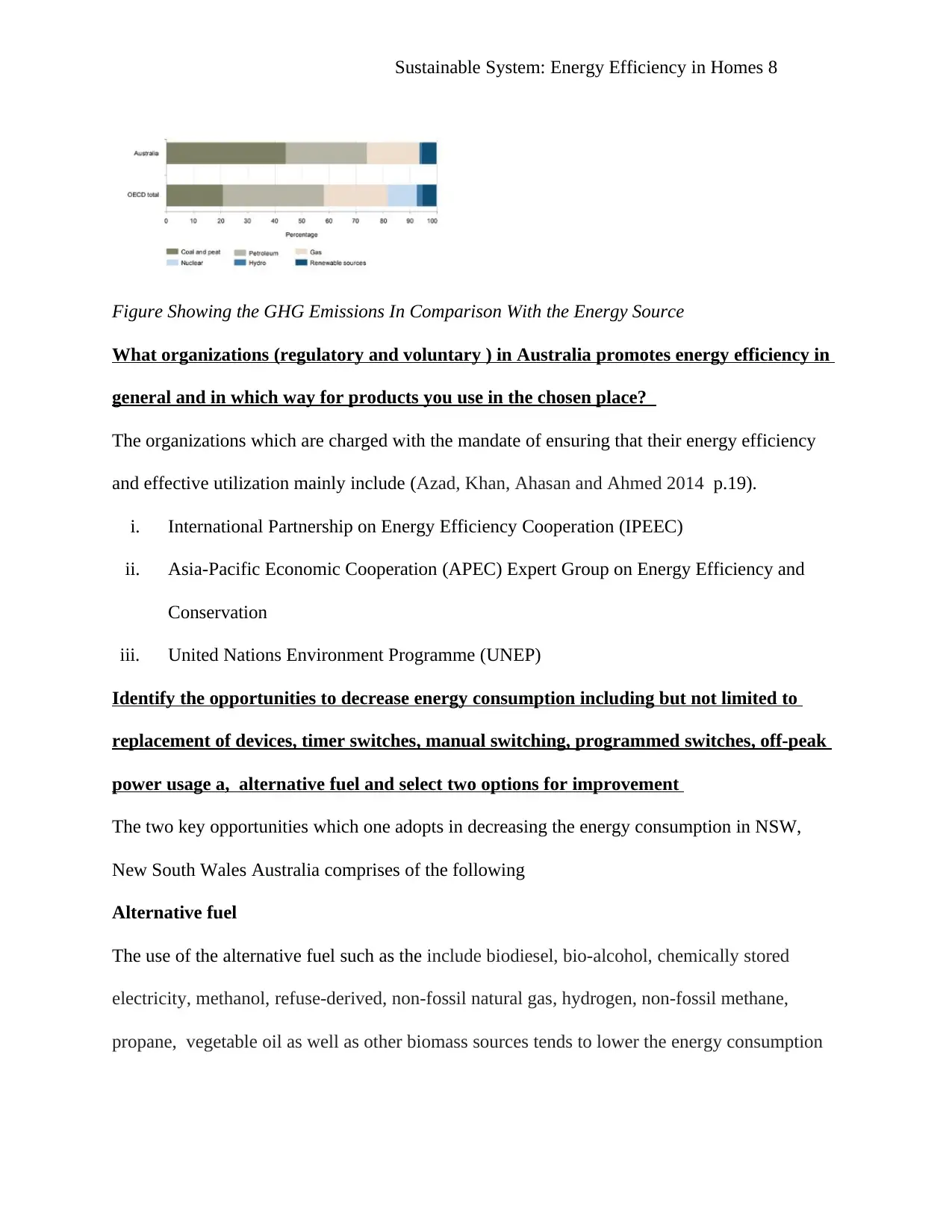
Sustainable System: Energy Efficiency in Homes 8
Figure Showing the GHG Emissions In Comparison With the Energy Source
What organizations (regulatory and voluntary ) in Australia promotes energy efficiency in
general and in which way for products you use in the chosen place?
The organizations which are charged with the mandate of ensuring that their energy efficiency
and effective utilization mainly include (Azad, Khan, Ahasan and Ahmed 2014 p.19).
i. International Partnership on Energy Efficiency Cooperation (IPEEC)
ii. Asia-Pacific Economic Cooperation (APEC) Expert Group on Energy Efficiency and
Conservation
iii. United Nations Environment Programme (UNEP)
Identify the opportunities to decrease energy consumption including but not limited to
replacement of devices, timer switches, manual switching, programmed switches, off-peak
power usage a, alternative fuel and select two options for improvement
The two key opportunities which one adopts in decreasing the energy consumption in NSW,
New South Wales Australia comprises of the following
Alternative fuel
The use of the alternative fuel such as the include biodiesel, bio-alcohol, chemically stored
electricity, methanol, refuse-derived, non-fossil natural gas, hydrogen, non-fossil methane,
propane, vegetable oil as well as other biomass sources tends to lower the energy consumption
Figure Showing the GHG Emissions In Comparison With the Energy Source
What organizations (regulatory and voluntary ) in Australia promotes energy efficiency in
general and in which way for products you use in the chosen place?
The organizations which are charged with the mandate of ensuring that their energy efficiency
and effective utilization mainly include (Azad, Khan, Ahasan and Ahmed 2014 p.19).
i. International Partnership on Energy Efficiency Cooperation (IPEEC)
ii. Asia-Pacific Economic Cooperation (APEC) Expert Group on Energy Efficiency and
Conservation
iii. United Nations Environment Programme (UNEP)
Identify the opportunities to decrease energy consumption including but not limited to
replacement of devices, timer switches, manual switching, programmed switches, off-peak
power usage a, alternative fuel and select two options for improvement
The two key opportunities which one adopts in decreasing the energy consumption in NSW,
New South Wales Australia comprises of the following
Alternative fuel
The use of the alternative fuel such as the include biodiesel, bio-alcohol, chemically stored
electricity, methanol, refuse-derived, non-fossil natural gas, hydrogen, non-fossil methane,
propane, vegetable oil as well as other biomass sources tends to lower the energy consumption
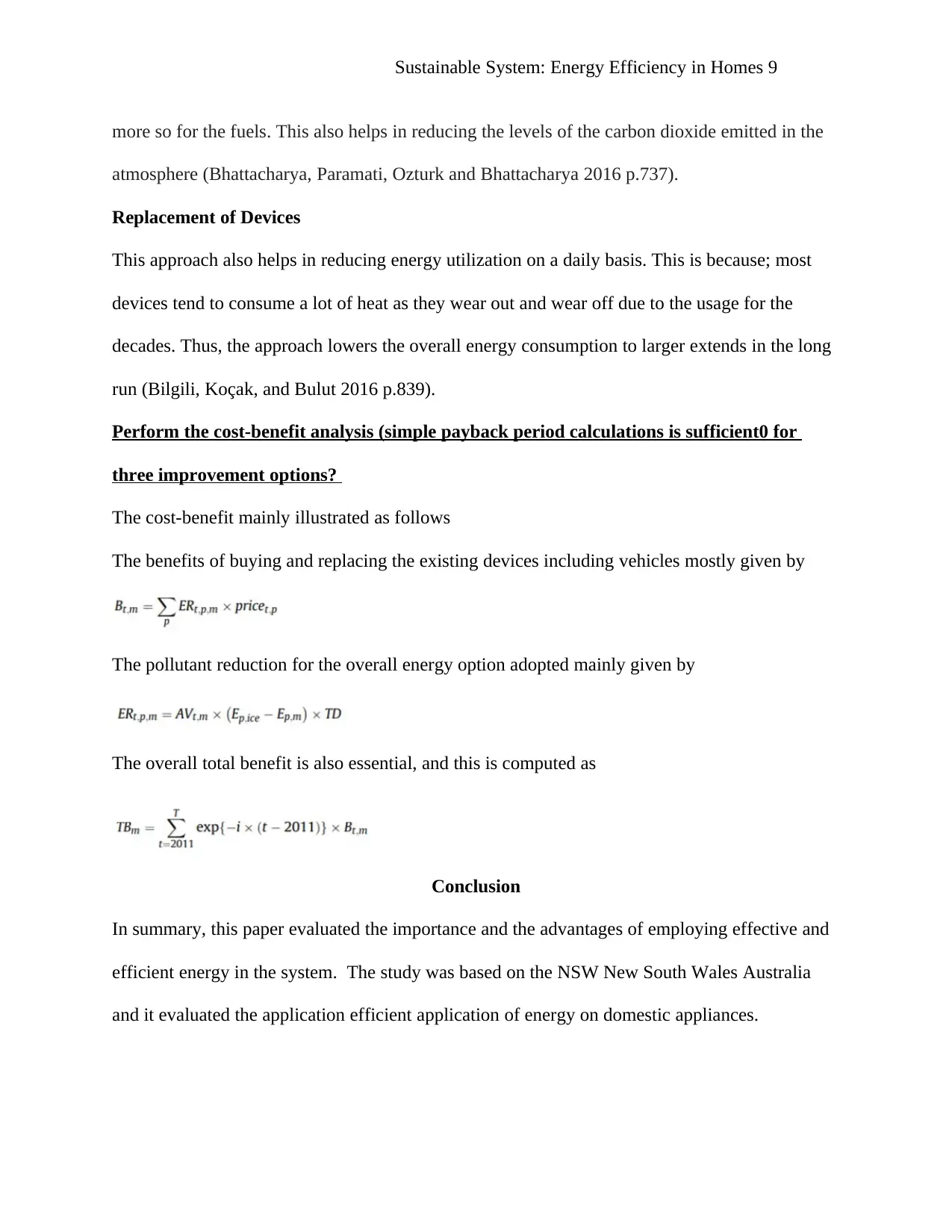
Sustainable System: Energy Efficiency in Homes 9
more so for the fuels. This also helps in reducing the levels of the carbon dioxide emitted in the
atmosphere (Bhattacharya, Paramati, Ozturk and Bhattacharya 2016 p.737).
Replacement of Devices
This approach also helps in reducing energy utilization on a daily basis. This is because; most
devices tend to consume a lot of heat as they wear out and wear off due to the usage for the
decades. Thus, the approach lowers the overall energy consumption to larger extends in the long
run (Bilgili, Koçak, and Bulut 2016 p.839).
Perform the cost-benefit analysis (simple payback period calculations is sufficient0 for
three improvement options?
The cost-benefit mainly illustrated as follows
The benefits of buying and replacing the existing devices including vehicles mostly given by
The pollutant reduction for the overall energy option adopted mainly given by
The overall total benefit is also essential, and this is computed as
Conclusion
In summary, this paper evaluated the importance and the advantages of employing effective and
efficient energy in the system. The study was based on the NSW New South Wales Australia
and it evaluated the application efficient application of energy on domestic appliances.
more so for the fuels. This also helps in reducing the levels of the carbon dioxide emitted in the
atmosphere (Bhattacharya, Paramati, Ozturk and Bhattacharya 2016 p.737).
Replacement of Devices
This approach also helps in reducing energy utilization on a daily basis. This is because; most
devices tend to consume a lot of heat as they wear out and wear off due to the usage for the
decades. Thus, the approach lowers the overall energy consumption to larger extends in the long
run (Bilgili, Koçak, and Bulut 2016 p.839).
Perform the cost-benefit analysis (simple payback period calculations is sufficient0 for
three improvement options?
The cost-benefit mainly illustrated as follows
The benefits of buying and replacing the existing devices including vehicles mostly given by
The pollutant reduction for the overall energy option adopted mainly given by
The overall total benefit is also essential, and this is computed as
Conclusion
In summary, this paper evaluated the importance and the advantages of employing effective and
efficient energy in the system. The study was based on the NSW New South Wales Australia
and it evaluated the application efficient application of energy on domestic appliances.
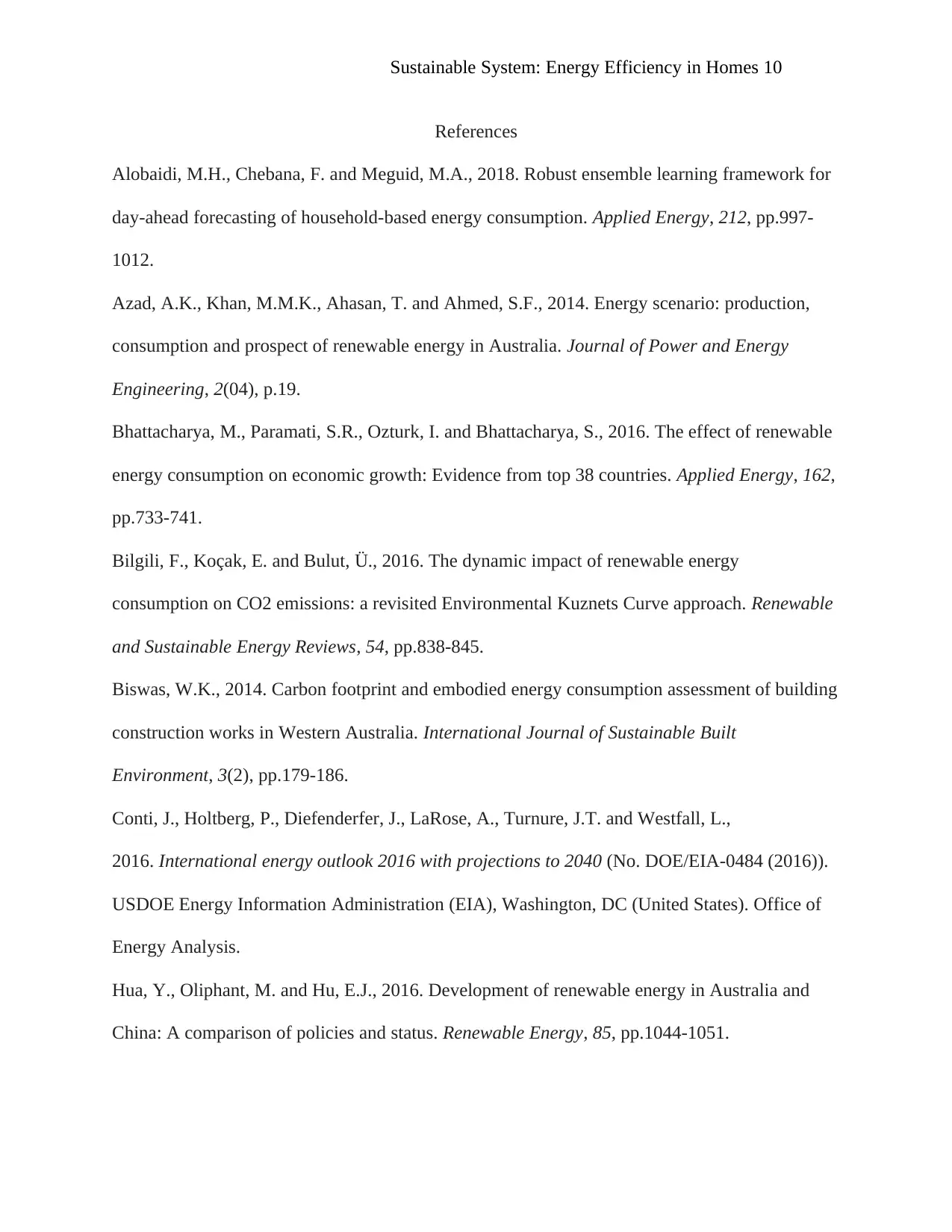
Sustainable System: Energy Efficiency in Homes 10
References
Alobaidi, M.H., Chebana, F. and Meguid, M.A., 2018. Robust ensemble learning framework for
day-ahead forecasting of household-based energy consumption. Applied Energy, 212, pp.997-
1012.
Azad, A.K., Khan, M.M.K., Ahasan, T. and Ahmed, S.F., 2014. Energy scenario: production,
consumption and prospect of renewable energy in Australia. Journal of Power and Energy
Engineering, 2(04), p.19.
Bhattacharya, M., Paramati, S.R., Ozturk, I. and Bhattacharya, S., 2016. The effect of renewable
energy consumption on economic growth: Evidence from top 38 countries. Applied Energy, 162,
pp.733-741.
Bilgili, F., Koçak, E. and Bulut, Ü., 2016. The dynamic impact of renewable energy
consumption on CO2 emissions: a revisited Environmental Kuznets Curve approach. Renewable
and Sustainable Energy Reviews, 54, pp.838-845.
Biswas, W.K., 2014. Carbon footprint and embodied energy consumption assessment of building
construction works in Western Australia. International Journal of Sustainable Built
Environment, 3(2), pp.179-186.
Conti, J., Holtberg, P., Diefenderfer, J., LaRose, A., Turnure, J.T. and Westfall, L.,
2016. International energy outlook 2016 with projections to 2040 (No. DOE/EIA-0484 (2016)).
USDOE Energy Information Administration (EIA), Washington, DC (United States). Office of
Energy Analysis.
Hua, Y., Oliphant, M. and Hu, E.J., 2016. Development of renewable energy in Australia and
China: A comparison of policies and status. Renewable Energy, 85, pp.1044-1051.
References
Alobaidi, M.H., Chebana, F. and Meguid, M.A., 2018. Robust ensemble learning framework for
day-ahead forecasting of household-based energy consumption. Applied Energy, 212, pp.997-
1012.
Azad, A.K., Khan, M.M.K., Ahasan, T. and Ahmed, S.F., 2014. Energy scenario: production,
consumption and prospect of renewable energy in Australia. Journal of Power and Energy
Engineering, 2(04), p.19.
Bhattacharya, M., Paramati, S.R., Ozturk, I. and Bhattacharya, S., 2016. The effect of renewable
energy consumption on economic growth: Evidence from top 38 countries. Applied Energy, 162,
pp.733-741.
Bilgili, F., Koçak, E. and Bulut, Ü., 2016. The dynamic impact of renewable energy
consumption on CO2 emissions: a revisited Environmental Kuznets Curve approach. Renewable
and Sustainable Energy Reviews, 54, pp.838-845.
Biswas, W.K., 2014. Carbon footprint and embodied energy consumption assessment of building
construction works in Western Australia. International Journal of Sustainable Built
Environment, 3(2), pp.179-186.
Conti, J., Holtberg, P., Diefenderfer, J., LaRose, A., Turnure, J.T. and Westfall, L.,
2016. International energy outlook 2016 with projections to 2040 (No. DOE/EIA-0484 (2016)).
USDOE Energy Information Administration (EIA), Washington, DC (United States). Office of
Energy Analysis.
Hua, Y., Oliphant, M. and Hu, E.J., 2016. Development of renewable energy in Australia and
China: A comparison of policies and status. Renewable Energy, 85, pp.1044-1051.
Secure Best Marks with AI Grader
Need help grading? Try our AI Grader for instant feedback on your assignments.
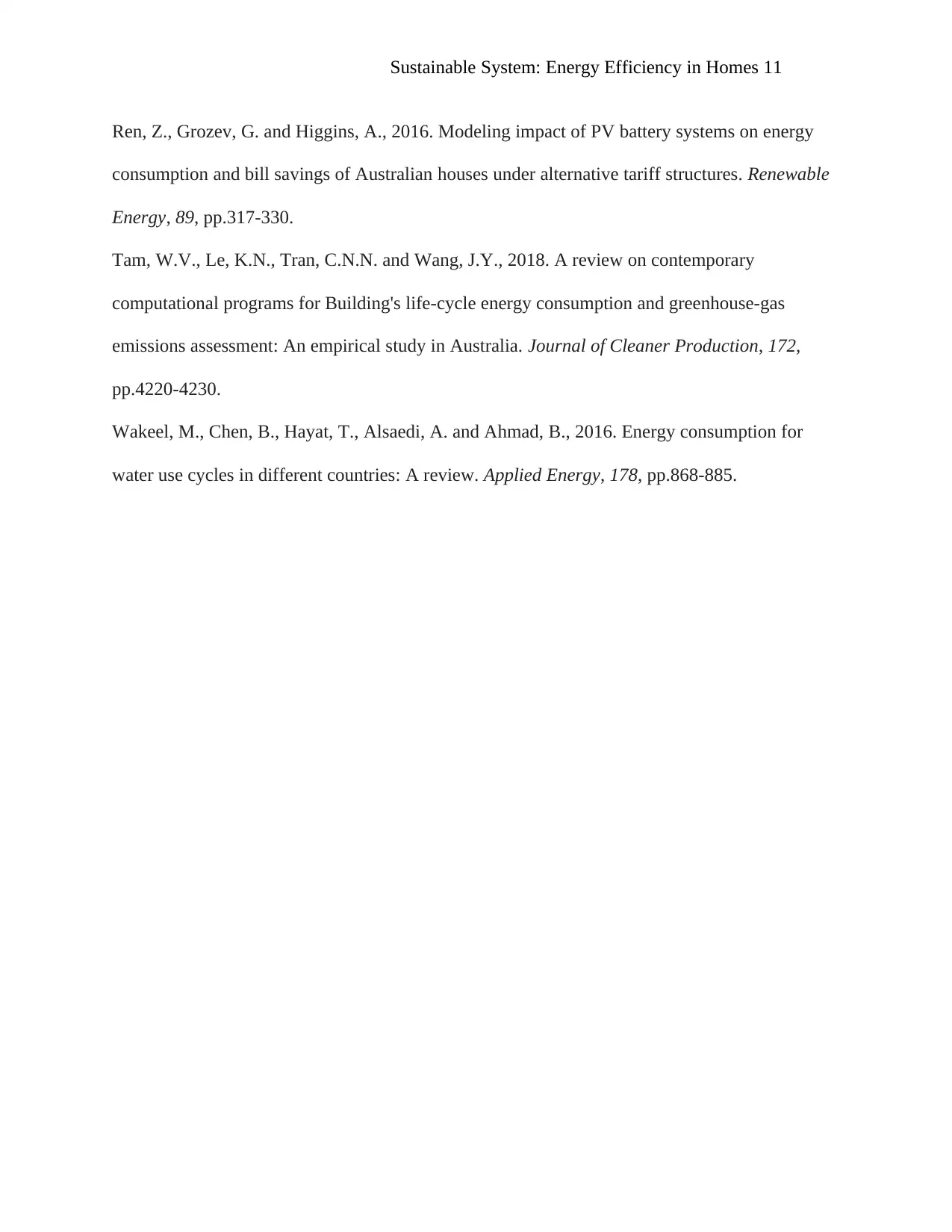
Sustainable System: Energy Efficiency in Homes 11
Ren, Z., Grozev, G. and Higgins, A., 2016. Modeling impact of PV battery systems on energy
consumption and bill savings of Australian houses under alternative tariff structures. Renewable
Energy, 89, pp.317-330.
Tam, W.V., Le, K.N., Tran, C.N.N. and Wang, J.Y., 2018. A review on contemporary
computational programs for Building's life-cycle energy consumption and greenhouse-gas
emissions assessment: An empirical study in Australia. Journal of Cleaner Production, 172,
pp.4220-4230.
Wakeel, M., Chen, B., Hayat, T., Alsaedi, A. and Ahmad, B., 2016. Energy consumption for
water use cycles in different countries: A review. Applied Energy, 178, pp.868-885.
Ren, Z., Grozev, G. and Higgins, A., 2016. Modeling impact of PV battery systems on energy
consumption and bill savings of Australian houses under alternative tariff structures. Renewable
Energy, 89, pp.317-330.
Tam, W.V., Le, K.N., Tran, C.N.N. and Wang, J.Y., 2018. A review on contemporary
computational programs for Building's life-cycle energy consumption and greenhouse-gas
emissions assessment: An empirical study in Australia. Journal of Cleaner Production, 172,
pp.4220-4230.
Wakeel, M., Chen, B., Hayat, T., Alsaedi, A. and Ahmad, B., 2016. Energy consumption for
water use cycles in different countries: A review. Applied Energy, 178, pp.868-885.
1 out of 11
Related Documents
Your All-in-One AI-Powered Toolkit for Academic Success.
+13062052269
info@desklib.com
Available 24*7 on WhatsApp / Email
![[object Object]](/_next/static/media/star-bottom.7253800d.svg)
Unlock your academic potential
© 2024 | Zucol Services PVT LTD | All rights reserved.





